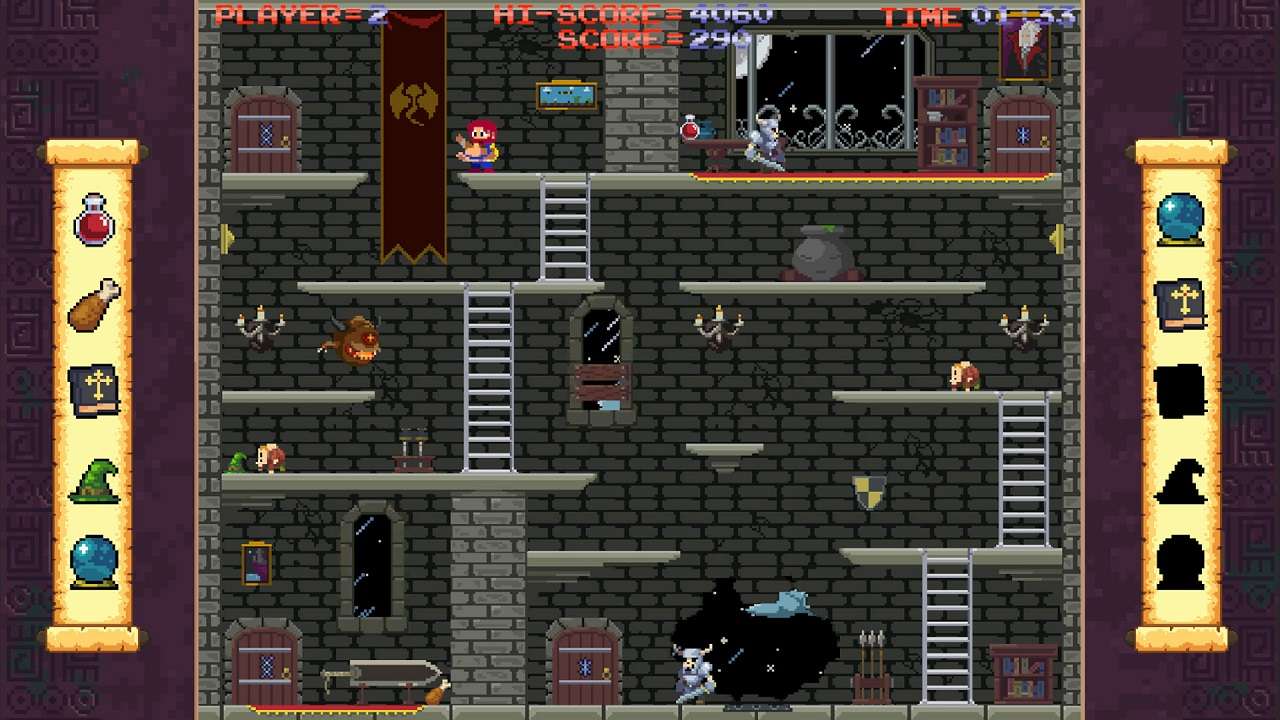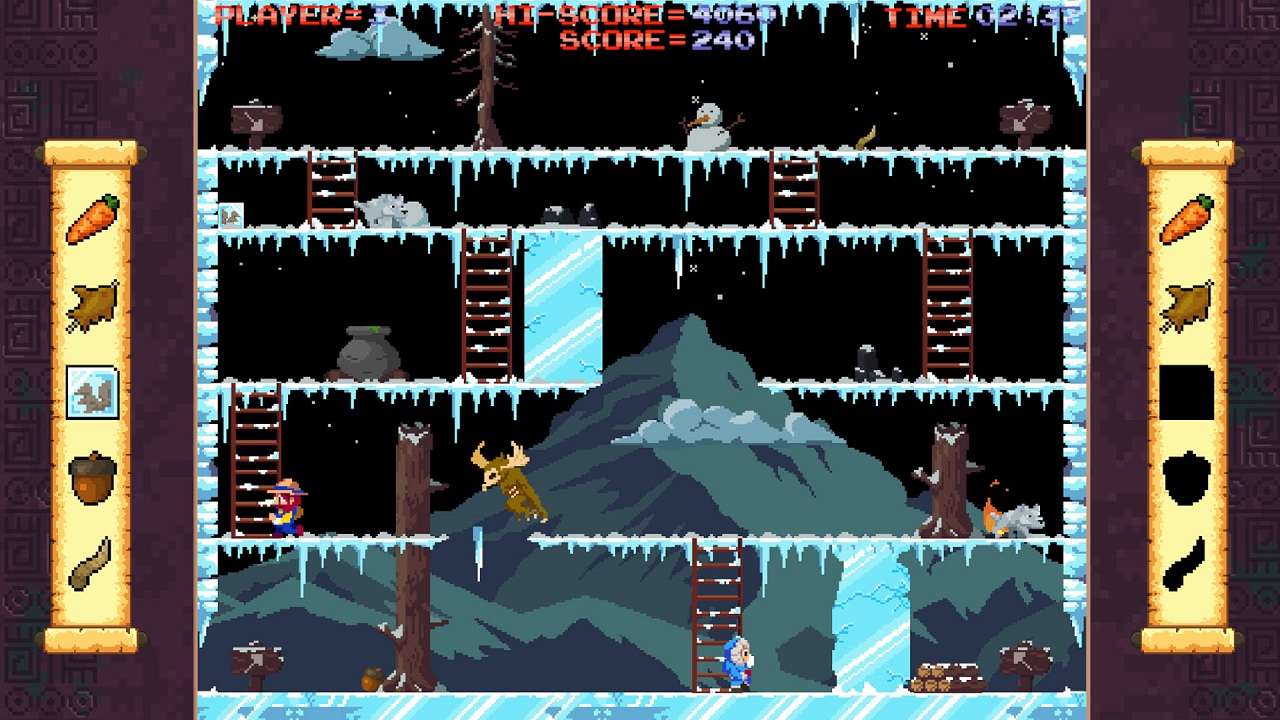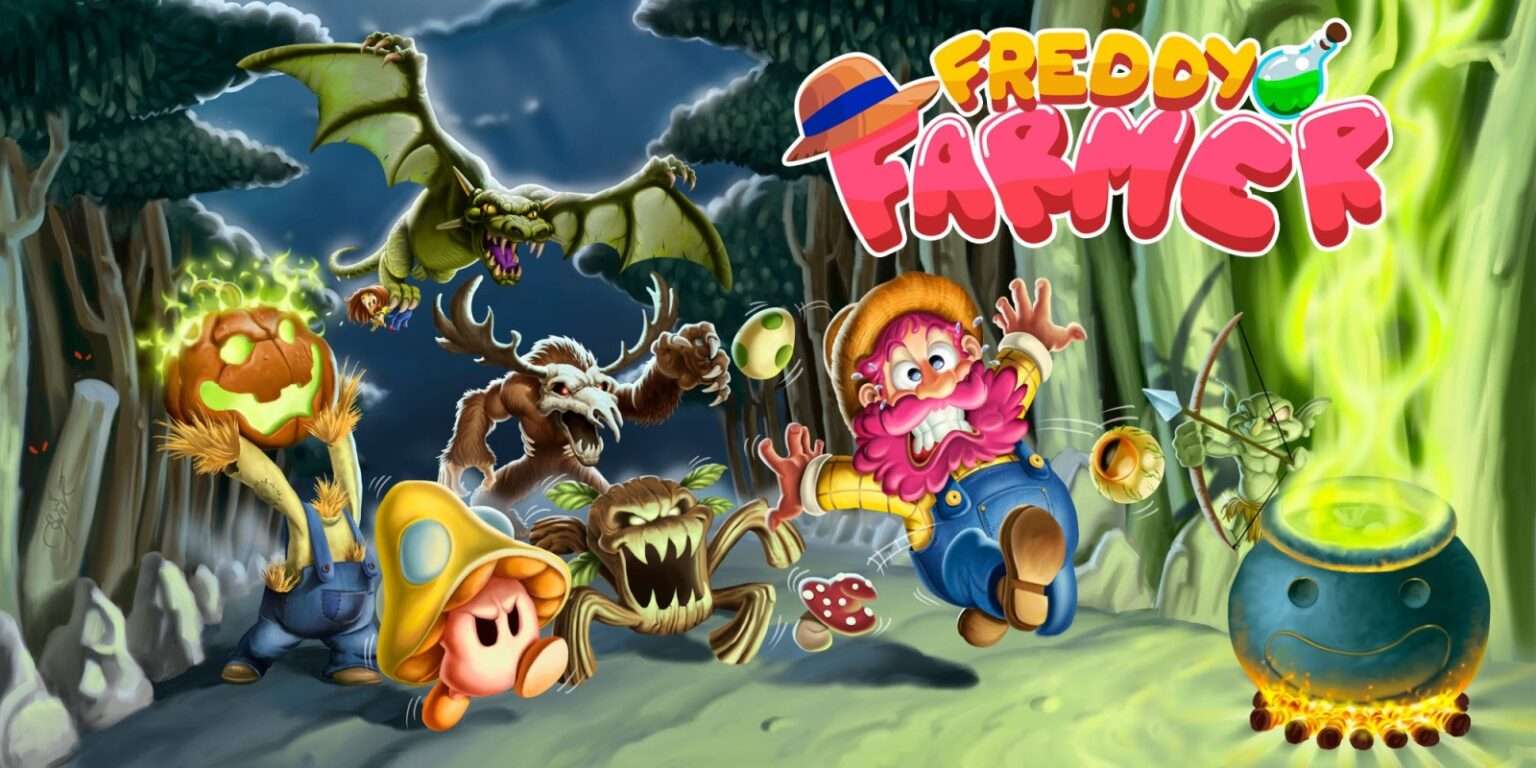This review of Freddy Farmer is played and tested on Nintendo Switch. Freddy Farmer is also available on PC (Steam). The game is available for $/€ 4,99.
It is interesting to see that, with all the retro releases nowadays, one genre from the olden days never really took off with the new generation of indie-developers. Maybe it’s because it is hard to combine the single-screen puzzle platformer genre, I’m talking about, with modern mechanics like rogue-lite RPG elements or deck-building. Thankfully, publisher/developer Flynn’s Arcade has a knack for delivering solid retro arcade games, especially in this once-revered subgenre. The recently released Freddy Farmer is another game in the critically acclaimed lineage of puzzle platformers like Donut Dodo, Murtop, Goliath Depot and Cash Cow. On this site, we have reviewed many of these (and other Flynn’s Arcade games) and can almost blindly trust the quality output of the team from Barcelona. Great roots or not, we gave Freddy Farmer a good hard look to see if it has kept up with its predecessors.
Classic arcade gameplay
Freddy Farmer follows the core essential principles of arcade gaming made popular between 1980 and 1986. The glorious period before arcade boards became more powerful and the industry shifted toward beat ’em ups, fighting games and shmups. In essence the formula is simple: every level is a single screen, with one objective and a mechanic to score additional points. Simple enough indeed, but history shows that adding a special flavour is needed to really make a game like this stand out. Usually in the form of a unique game mechanic.

The game sets the scene with Freddy Farmer witnessing his daughter’s kidnapping by a mysterious evil dragon. In desperation, he turns to a local wizard, who advises him to gather ingredients spread throughout the five worlds and make magic potions that could save his daughter from the clutches of evil.
Shopping for potions
Gameplay consists of platform levels where five ingredients must be collected without Freddy being grabbed (i.e., touched) by various ghouls, slimes, zombies and other fairy-tale monsters. While there are ladders to climb and gaps to jump, Freddy’s limited jumping ability prevents him from clearing wide gaps or reaching high platforms easily. This requires you to carefully plan your route through each level.
To create the most potent potion, ingredients must be collected in the exact order shown on the left side of the screen. Doing so grants the best potion and the maximum amount of bonus points. Once all ingredients are collected, they must be brought to the cauldron to complete the level.
Level structure and progression
The game features five different areas, each consisting of seven stages. You can choose which world to play and once a world is completed, the potions created are recorded as progress. Each playthrough grants three lives and when a life is lost players continue from where they perished. Occasionally, a fairy flies by and catching it grants an extra life. These fairies appear often, making it possible to build up a buffer of extra lives for later stages.

The placement of ingredients forces players to navigate each level in multiple ways. Freddy is a farmer, not a fighter, so he has no means of attack—only avoidance and patience will get the job done. His limited jump height means some enemies, like the gassy toadstool in the first couple of levels, cannot be jumped over. This makes positioning crucial to avoid being trapped between a wall and an enemy with no escape route.
Learning curve and difficulty
Early on, learning the levels and enemy behaviors can feel daunting and the first few stages feel pretty challenging. However after a few attempts you will develop a better sense of enemy movement, Freddy’s abilities and the jump mechanic. Each new world introduces fresh environmental hazards and enemies, requiring constant adaptation. Like Goliath Depot and Donut Dodo, Freddy Farmer takes a seemingly simple concept and adds depth through smart progression mechanics. The build up in level difficulty is fairly steady after the initial acclimatization, although you always have to stay focused with the aforementioned snafu of being soft-locked in a corner always looming.
Online leaderboards
Your scores are kept on a worldwide leaderboard – a tradition in Flynn’s Arcade games. However, instead of being visible or accessible within the game, it is available online. When you set a score, you are asked whether or not you want to upload it to the leaderboard. A QR-code can be used to open the leaderboard on your phone. Given the leaderboard issues in other games, such as scores failing to register, this solution feels clumsy, but at least it works. Additionally, you do not need to (neither can you) use your Switch to check scores, you can reference your own and others’ scores at any time once you have bookmarked the leaderboard URL.
Visuals and audio
Visually, Freddy Farmer aligns with many of the developer’s previous games—colorful, sharp and loaded with 16-bit charm, upped with more frames of animation. Compared to Donut Dodo, the backgrounds are more detailed and vibrant. While the pixel art may not be a major draw, it is well-executed and unlikely to deter any players.

The music is fairly repetitive if you linger in a world and level too long, mainly because the in-game score in certain worlds is fairly limited. Also, some of the songs are high octane affairs that are somewhat intrusive to your mental state, especially when you have to deal with mentally demanding platforming.
Gameplay quirks and frustrations
The game has a few frustrating mechanics that seem to have been introduced for difficulty balancing. One of the biggest issues is the ladder system – once Freddy starts climbing, he cannot stop or change direction until he reaches the top or bottom. If you have to escape a toadstool that is about to lock you up with the ladder as the only means to espace you had better hope the ghoul on the platform above doesn’t cross at the same time. In this case you have two options of forced suicide. It’s cheap, nasty, unavoidable and above all not fun.
Another odd choice is Freddy’s idle animation. If he stands still for too long, he falls asleep Sonic-style. When it is time to move there is a short delay as he wakes up. Given that many levels require you to wait for a toadstool to pass by and a gap to open up, this animation kicks in too often. Once it happens two or three times per level it can be mildly infuriating and feels unnecessary.
A worthwhile arcade experience
Flynn’s Arcade has kept Freddy Farmer engaging by balancing arcade-style short-burst gameplay with a layer of overall progression that encourages replayability. The combination of varied worlds and persistent progress makes for a compelling experience. Those invested in the leaderboard competition can extend that playtime much longer. But the special ingredient in the cauldron that should make this a standout title, isn’t really there. There is no equivalent to Bomb Jack‘s super jump and steerable decent or Bubble Bobble‘s chain reacting and jumpable bubbles. Apart from that and a few frustrating mechanics, the game delivers a solid challenge that can keep you entertained for 5 to 10 hours, but also lacks a standout mechanic to make this a real retrolike evergreen.
Although being firm competition to Flynn's Arcade own offerings in this underused genre, the special ingredient in the cauldron that should make Freddy Farmer a real standout title, isn't really there. There is no equivalent to Bomb Jack's 'super jump' and steerable decent or Bubble Bobble's chain reacting and jumpable bubbles. That said, apart from that and a few frustrating mechanics, Freddy Farmer is a lot of fun and delivers a solid challenge that can keep you entertained for 5 to 10 hours.
The good
- Lush and colorful 16-bit graphics
- Lots of levels to play for a mere €/$ 4,99
- Engaging but balanced difficulty curve
- It offers a lot of enemy variation.
The bad
- Some questionable gameplay decisions made regarding idle time and the use of ladders
- Music can be in your face from time to time.


